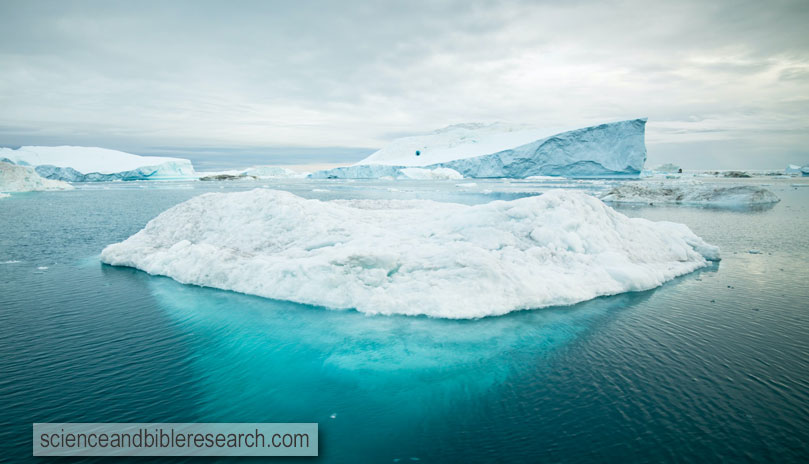March 11, 2023
Steve Sabz

Arctic Icebergs in Ilulissat, Greenland (Photo by Alexander Hafemann)
Human civilization did not always enjoy a time of extreme climate stability
as is the case in Earth's current interglacial stage of transformation. Periods of widespread glaciation
of Earth's
continents have occurred since the Precambrian era (more than 570 million years ago), to as recently as
2.6 million to 11,700 years ago during the Pleistocene Epoch.
Several theories have been postulated to explain the cause of such massive glacial progression.
Astrophysicist, Hugh Ross, of Reasons to Believe, cites cyclical
variations in Earth's rotation axis
tilt, and cyclical variations in the elliptical shape or eccentricity of Earth's orbit about the Sun
as the two "primary natural drivers of the ice age cycle" (source).
Young Earth Creationist (YEC) organizations, such as the Institute for Creation Research (ICR),
Creation
Ministries International (CMI), and Ken Ham's Answers in Genesis (AiG), all postulate a global flood
as the
cause of the last Ice Age. If indeed Noah's Flood encompassed the whole of planet Earth, along with
concomitant geologic upheaval, then perhaps an Ice Age would occur. However, this presents an enormous problem for the Young Earther, since the enormous amounts of heat generated as a result of accelerated radioactive decay during the five-month duration of the Flood (Gen 7:24) would have vaporized all life-forms from the planet.
As we shall see in this article, a Post-Flood Ice Age challenges biblical authority and breaks
God's promise to Noah after disembarking the ark. For example, The word "snow" is used 24 times in the Bible, but never in relation to the Post-Flood environment. The only time the Bible mentions snowfall is during King David's reign (2Sa 23:20, xref. 1Ch 11:22). The Bible also mentions "ice" four times, but again, never in relation to the Post-Flood environment.
Universal or Global?
Young Earthers insist that Noah's Flood was global, rather than universal. A global
Genesis Flood is one
that covers the entire planet Earth, even where no humans inhabit. Andrew A. Snelling, writing for
AiG
states, "...torrential rain fell globally... all the high hills and the mountains-the whole
earth-was covered by a global ocean" (source).
Conversely, a universal Genesis Flood is one that occurs locally within a defined region of
the Earth, and
affects all of humanity, yet doesn't include regions where humanity had not yet migrated. This makes sense because the
purpose of Noah's Flood in the first place was to destroy the wicked, along with the land animals and
birds associated with them (Gen 6:7).
Snelling uses two Bible passages to support the global flood scenario. These include Genesis 7:11,
where Moses writes, "all the fountains of the great deep burst forth", and 2 Peter 3:6, where Peter
writes, "the world that then existed was deluged with water and perished." However, other passages
in the New Testament use the phrase, "the world", yet we know from the context that the writer did not
mean all of planet Earth. For example, Luke writes that a great famine was over "all the world" (Act
11:28, xref. Luk 2:1) during Roman Emperor Claudius' reign (41-54 AD). This was an obvious reference
to the Roman Empire-governed world and its citizenry, not the entire Earth. Furthermore, the phrase,
"all the fountains of the great deep" (Gen 7:11), does not require a global flood. All of the
subterranean and suboceanic stores of water could more reasonably refer to those fountains in the
part of the Earth where wicked humanity was confined at the time, just like other natural phenomena such as earthquakes which only affect specific regions.
The only reason to suppose that Noah's Flood was global would be if humanity had spread out
globally. But this was not the case, since Scripture never states that humans had occupied every
corner of the Earth prior to the Flood. Even after the Flood, humanity stubbornly intended to remain
confined to one region (Gen 11:4). This was why God "dispersed them from there over the face of all the earth"
(Gen 11:8) after confusing their language at the Tower of Babel (Gen 11:9). Hence, it wasn't until
after the Tower of Babel incident that humanity was forced to migrate out of a local region.
Impossible Rainbow
Michael J. Oard, writing for AiG, states that cool temperatures and tons of snow were
"dramatically fulfilled immediately after the Genesis flood." Oard states that colder temperatures
were triggered by "huge volumes of volcanic ash and gas that had spewed into the atmosphere", which
he estimates would take "at least three years to fall out." This would result in a nuclear winter
that would "block out nearly all sunlight all over the world for several months" (source).
Young Earthers may eisegetically suppose that God miraculously opened a window through the huge volumes of volcanic ash and gas so Noah could see the rainbow in the clouds. This is fallacious, since when a miracle is performed in Scripture, it is explicitly stated as such (Exo 7:3). Furthermore, it is odd that Moses would fail to mention the tons of snow and sub-zero temperatures all around Noah as he observed a miraculous rainbow in an ash-filled atmosphere.
If Oard's Post-Flood nuclear winter actually happened, then God's use of the rainbow (Gen 9:13-17) as
a sign of his promise to never again destroy all of humanity with a flood (Gen 9:11) would have been
impossible for Noah to see in an ash-filled atmosphere, since rainbows are the result of the refraction and reflection of light.
Cold and Dark
In addition to the obvious darkness in the absence of sunlight, Oard's supposed Post-Flood Ice
Age would have resulted in the absence of the summer months as well. He refers to the 1815 localized
volcanic eruption of Mount Tambora in Indonesia that resulted in the "year without a summer."
Furthermore, resultant temperatures would drop below-freezing "over the entire globe" (source). If this is at all
accurate as Oard claims, then God's promise to Noah that, "cold and heat, summer and winter, day and
night, shall not cease" (Gen 8:22), went completely or partly unfulfilled for centuries after the Flood. Thus, a YEC Post-Flood Ice Age would have
resulted in a failure on God's part to keep his promise, since Noah would have died half-way through
the Ice Age (Gen 9:28), which is supposed to have lasted 700 years after the Flood (source). In addition, his eldest son, Shem, would have died 200 years before the Ice Age was supposed to have ended (Gen 11:10-11).
In summary, we know that the ark landed in the region of Ararat, located in eastern Turkey, on the 17th day of the seventh month (Gen 8:4), and that Noah left the ark on the 27th day of the second month when "the earth had dried out" (Gen 8:14-19). This mountain region contains two volcanoes (Greater and Lesser Ararat), both of which are glaciated (source). The eruption of volcanoes all over the world, which ICR physicist Dr. Jake Hebert claims continued for "hundreds of years" after the Flood (video source, time 12:45), would have caused the atmosphere to become filled with toxic ash and gas, blotting out the Sun and making the air hazardous to breathe for animals and vegetation (source). Noah and everything that survived the Flood would have suffocated on the volcanic ash and gas in the air. In addition, the absence of sunlight would have caused a nuclear winter (e.g., darkness, cold, etc.). Because of this, Noah would not have seen any rainbow (Gen 9:13). So heat, summer, day, seedtime and harvest, would have ceased after the Flood when God made the promise (Gen 8:22). Lastly, God's command to Noah and his family and the animals to "be fruitful and multiply on the earth" (Gen 8:17, Gen 9:1) under these conditions would have been extremely difficult to accomplish. It's interesting though, that while Noah had to live through such a hostile Post-Flood environment, if he survived at all, that the Bible makes no mention of any Post-Flood irregularities.
CITE:
Sabz, S. (2023, March 11). Post-Flood Ice Age Dilemma. Retrieved from
https://scienceandbibleresearch.com/post-flood-ice-age-dilemma.html
Steve Sabz
Steve Sabz is the author and founder of Science and Bible
Research. He has been studying theology since 2015 and has successfully completed seminary level
courses in Textual Criticism, Biblical Hermeneutics, Eschatology, Puritan Theology, Ancient Church
History, Soteriology, Biblical Theology, Prolegomena, and Biblical Greek from Puritan Reformed
Theological Seminary, Southern Baptist Theological Seminary, and Dallas Theological Seminary. Steve
is also the author of Evolution's Complexity
Problem: See How Evolution Falls Apart At Its Beginning and End Time Rewind: An Exploration In Bible Prophecy And The
Fate Of The World.






